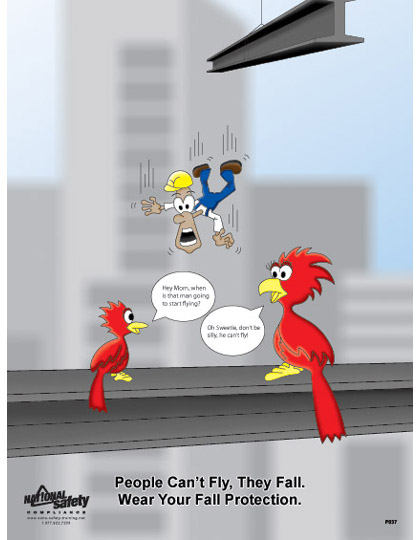This article is from the Canadian Centre for Occupational Health and Safety monthly newsletter that we subscribe to:
An apprentice carpenter was severely injured when he fell through a stairwell opening and landed on the concrete floor 37 feet below. In another incident, a roofer unhooked his lanyard from the lifeline and then slipped on frost, falling to his death, 53 feet below.
Every year workers die or are injured as a result of falling from ladders, scaffolds, roofs or other elevations. Falling is a risk faced by construction workers, painters, solar panel installers, window washers, firefighters, live performance workers, and others who work at heights. Ideally it would be safest to eliminate the risk all together by eliminating the need to work at heights, however in many occupations such as construction and other trades, this is not practical, and working at heights is a part of the job.
There are however, steps that employers and workers can take to minimize the risk, and help prevent falls and the injuries that go along with them.
Risk Assessment
Any work at heights should be properly planned, supervised, and not carried out in dangerous weather conditions. Conduct a risk assessment to identify and address any hazards related to the work to be performed. This information can help you select the right equipment for the job, and take adequate control measures and precautions to ensure the safety of workers and others.
Fall Protection Plan
When workers are working over 7.5 metres (25 feet) in height and are not protected by permanent guardrails the employee must develop a written, site-specific fall protection plan. The plan should include the fall hazards and fall protection systems that are in place in each area, and the procedures for using, maintaining, fitting and inspecting fall protection equipment. The plan should also include procedures for rescuing a worker who has fallen, and is suspended by a personal fall protection system or safety net.
Training and Supervision
People working at heights must be trained in practical fall prevention and fall arrest techniques. Whenever personal protective equipment is used, the employer must ensure that workers know how to properly select, fit, use, inspect, and maintain the gear they will be using. The employer is responsible for providing appropriate training, and safety equipment that complies with safety standards, and ensuring that workers use the fall protection system provided at all times.
Fall Protection
If you are at risk for falling three meters (ten feet) or more, you should use the appropriate fall protection system when working. There are various fall protection methods and devices to protect workers who are at risk of falling. Each has their appropriate uses; depending on the situation, use one or more of these fall protection methods:
Guardrails should be installed at the edges of construction sites, roofs, and scaffoldings whenever possible to prevent falls. Standards for guardrails dimensions may vary from province to province. Fall restraint systems such as work positioning devices that prevent workers from travelling to the edge of the building or structure must be provided if the use of guardrails isn’t practicable.
Fall arrest systems (full body harnesses and safety nets) are used to stop workers in mid-fall to prevent them from hitting the surface below. Full body safety harnesses attached to secured lanyards are widely used, however to be effective, they must be fitted properly to each worker. Although a poorly fitting harness will stop a fall, it can injure the worker who is dangling in mid-air if the straps and metal supports are not contoured to the individual’s shape.
The lanyard, or line that stops the fall, and the anchor point for the lanyard are just as important as the harness. Anchor points must be carefully planned, usually in consultation with an engineer, and the length of the lanyard must allow for the stretch in the material resulting from the fall. Manufacturers can provide information to help you choose the correct length and avoid contact with the ground or other objects.
Safety netting can be used effectively in construction of industrial framed buildings. Trained personnel are required to install, dismantle and inspect the netting, and no worker should work above nets without proper training.
Suspension Trauma
When fall arrest systems are used, the possibility of suspension trauma is a serious concern. This condition, which can be fatal, occurs when a person is suspended motionless in a vertical position in the harness while awaiting rescue. When a person is suspended vertically and perhaps in shock, blood tends to pool around the legs, putting extra pressure on the heart while it attempts to pump blood to the brain. The situation can be made worse by the constrictions of the harness. Suspended workers with head injuries or who are unconscious are particularly at risk. The person must be rescued quickly (under ten minutes) and gradually brought to a horizontal position to avoid potential cardiac arrest. This is why it is critical to have a rescue plan with procedures for rescuing a worker who is suspended by a personal fall protection system.
Preventing the fall, or rescuing the fallen, the best way to protect workers from injury is to create a culture of safety that values the input of both employers and workers.
Canadian Centre for Occupational Health and Safety
